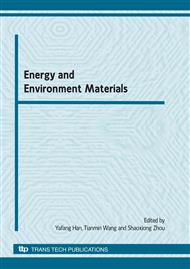[1]
C. Hunt and D. Lea. Wettability of Lead-Free Alloys. Proceedings of Apex 2000, Long Beach, CA. March (2000).
Google Scholar
[2]
J.S. Hwang. Solder Materials. SMT. July 2001, 15(7): 44-50.
Google Scholar
[3]
IPC Lead-Free Website: www. leadfree. org, NIST Database for Solder Properties with Emphasis on New Lead-free Solders.
Google Scholar
[4]
I.E. Anderson, T.E. Bloomer, R.L. Terpstra, J.C. Foley, B.A. Cook and J. Harringa. Development of Eutectic and Near-Eutectic Tin Silver Copper Solder Alloys for Lead-Free Electronic Assemblies. IPCWorks' 99: An International Summit on Lead-free Electronics Assemblies, Minneapolis, MN. October 24-28, (1999).
DOI: 10.2320/matertrans.43.1827
Google Scholar
[5]
W.B. Hampshire. The Search for Lead-Free Solders. Proc. Surface Mount International Conference, San Jose, CA. September 1992: 729.
Google Scholar
[6]
Z. Mei, J.W. Morris, Jr.M.C. Shine. Superplastic Creep of Eutectic Tin-Lead Solder joints. Journal of Electronic Packaging, 1991, 113: 109-114.
DOI: 10.1115/1.2905375
Google Scholar
[7]
J. McDougall, S. Choi, T.R. Bieler and J.P. Lucas. Quantitication of Creep Strain Distribution in Small Crept Lead-Free in-situ Composite and Non-composite Solder Joints. Materials Science and Engineering. 2000, A285: 25-29.
DOI: 10.1016/s0921-5093(00)00661-4
Google Scholar
[8]
F. Guo, J. Lee, S. Choi, J.P. Lucas, T.R. Bieler and K.N. Subranmanian. Processing and Aging Characteristics of Eutectic Sn-3. 5Ag Solder Reinforced with Mechanically Incorporated Ni Particles. J. Electronic Materials (in review).
DOI: 10.1007/s11664-001-0132-x
Google Scholar
[9]
S. Choi, J.P. Lucas, K.N. Subranmanian and T.R. Bieler. Formation and Growth of Interfacial Intermetallic Layers in Eutectic Sn-Ag Solder and its Composite Solder Joints. Journal of Materials Science: Materials in Electronics, 2000, 11: 497-501.
Google Scholar
[10]
J. Sigelko, S. Choi, K.N. Subranmanian and J.P. Lucas. The Effect of Small Additions of Copper on the Aging Kinetics of the Intermetallic Layer and Intermetallic Particles of Eutectic Tin-silver Solder Joints. J. Electronic Materials, 2000, 29: 1307-1311.
DOI: 10.1007/s11664-000-0130-4
Google Scholar
[11]
J. Sigelko, S. Choi, J.P. Lucas K.N. Subranmanian and T.R. Bieler. Effect of Cooling Rate on Micrestructure and Mechanical Properties of Eutectic Sn-Ag Soder Joints with and without Incorporated Cu6Sn5 Reinforcement. J. Electronic Materials, 1999, 28: 1184-1188.
DOI: 10.1007/s11664-999-0155-2
Google Scholar
[12]
X.H. Li, J.P. Xie, C.H. Guan and Y.M. Zhu. The Creep Behavior of Particles Enhanced ZA27 Based Composite Solder at High Temperature. Journal of Luoyang University of Technology, 2000, 21(1): 14-16.
Google Scholar
[13]
H. Mavoori and S. Jin. Significantly Enhanced Creep Resistance in Low-melting-point Solders through Nanoscale Oxide Dispersions. Applied Physics Letters, 1998, 73(16): 2290-2292.
DOI: 10.1063/1.121800
Google Scholar
[14]
F. Guo, J.P. Lucas, K.N. Subramanian. Creep Behavior in Cu and Ag Particles-reinforced Composite and Eutectic Sn-3. 5Ag and Sn-4. 0Ag-0. 5Cu Non-composite Solder Joints. Journal of Materials Science, 2001, 12: 27-35.
DOI: 10.1007/s11664-001-0150-8
Google Scholar
[15]
S. Choi, J. Lee, F. Guo, T.R. Bieler, K.N. Subamanian, and J.P. Lucas. Creep Properties of Eutectic Sn-Ag Solder and Sn-Ag Composite Solders Containing Intermetallic Particles. Electronic Materials(in review).
DOI: 10.1007/s11837-001-0098-4
Google Scholar
[16]
Yaowu Shi, Yanfu Yan,Jianping Liu,Zhidong Xia, Zhigang Chen, Yongping Lei and Xiaoyan Li. Metal Particles Enhanced SnCu Based Composite Solder and Its Manufacture. 2002, Patent No. 2003101168092.
Google Scholar
[17]
GB11364-89,Test Method of Spreadability and Clearance Filling Ability of Filler Metal, The Standard of The people Republic of China, (1989).
Google Scholar
[18]
J. McDougall, S. Choi, T.R. Bieler, K.N. Subramanian and J.P. Lucas, Materials Science and Engineering. 2000, A285(25): 471-477.
Google Scholar
[19]
Xi Zou. Soldering and Brazing. Beijing: Mechanical Industry Press. (1989).
Google Scholar
[20]
R.G. Ross. Crack Propagation in Solder Joints During Thermal-Mechanical Cycling. Journal of Electronic Packaging, 1994, 116(2): 68-75.
DOI: 10.1115/1.2905507
Google Scholar


